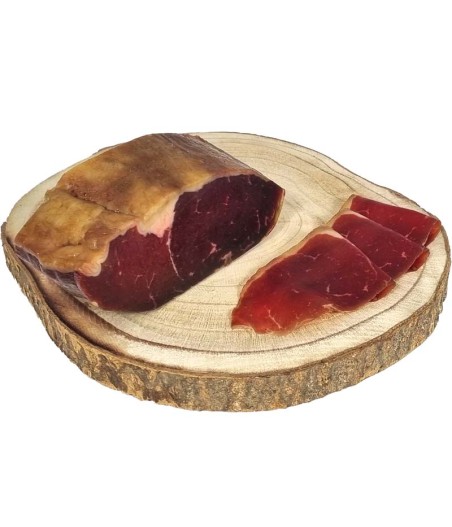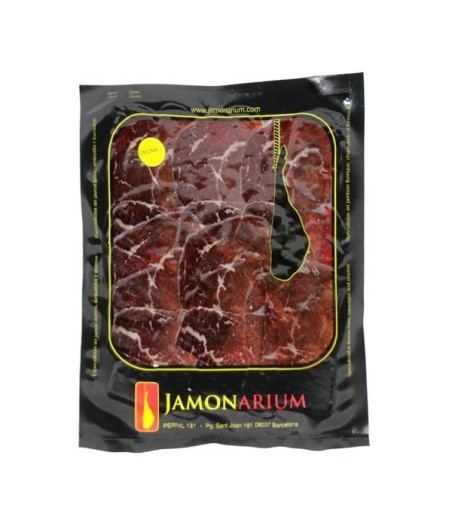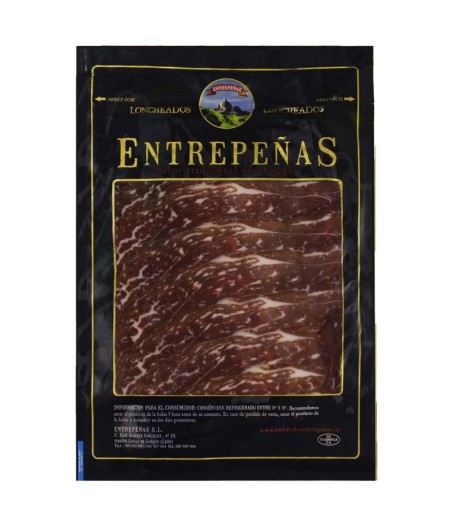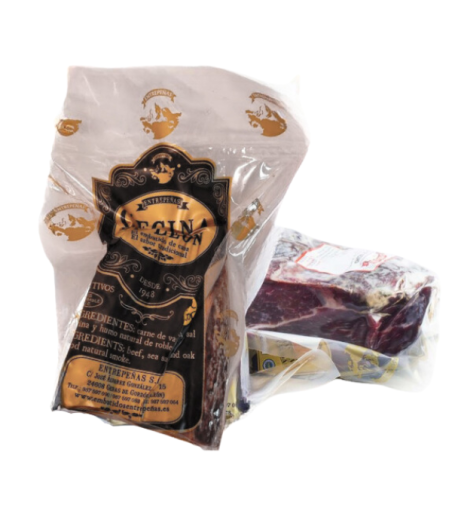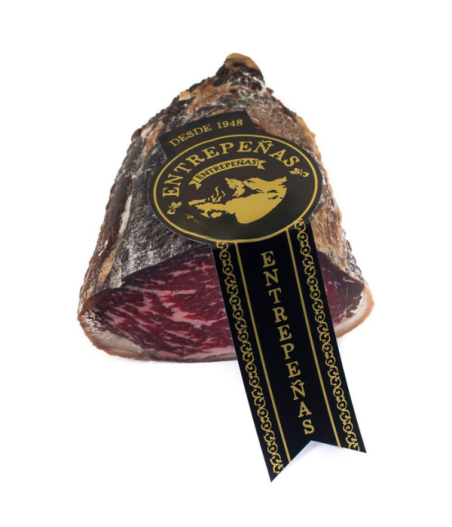About the Cecina dried beef
- What is the dried beef ‘Cecina’?
- Dried beef characteristics
- How is made the 'cecina’ dried beef?
- What part is extracted to make the 'cecina' dried beef?
- Where dried beef is produced?
- History of the dried beef from León
- What properties have the dried beef?
- What is the difference between dried beef and ham?
- What kind of dried beef there are?
- Dried beef ‘cecina’ Recipes
Our Dried Beef
1. What is the dried beef ‘Cecina’?
The dried beef ‘Cecina’ is a type of dried beef meat with Spanish origin, a type of salty, and air dried in the sun or smoked meat. It is also made in places like Paraguay and Peru, similar to ham but made by cured beef meat or cured horse meat and very rarely, young goat, rabbit, ox or hare.
The dried beef ‘cecina’ in Spain with Protected Geographical Indication are the one from the cow (‘dried beef’ cecina from León) and calf ‘cecina’ from Vegacervera. There are several festivals around the product, such as the "Fair of cecina", held in early November in the village of Vegacervera.
- Dried beef ‘Cecina’ from León
Regulation of IGP (Protected Geographical Indication) ‘Cecina from León’ was approved by an order on July 12, 1994, thus ensuring product quality. It is a variety of cured meat that is produced in the province of Leon with beef. It is listed since 1994 as a Protected Geographical Indication.
According to this regulation, the meat used for the preparation of Cecina preferably comes from indigenous breeds of Castile and Leon. To get the dried beef ‘cecina’ from Leon, four parts or cuts hindquarters of the cow are selected: ‘tapa’, ‘babilla’, ‘contra’ and hip; they must have a minimum of five years and a minimum weight of 400 kilograms (alive).
If you want to see all our Cecina products, click here
2. Dried beef characteristics
When the product is ready to be sold, the dried beef Cecina from León has the following characteristics:
- Dried beef appearance and color
Toasted tones, reddish brown and slightly darker as to the process belong, similes to ham tones.
- Weight
Tapa (eye round): 4 kg.
Contra (botton round): 5 kg.
Babilla (sirloin tip): 3,5 kg.
Hip (round tip): 3 kg.
- Dried beef flavor and taste
With a little salty taste, low fibrous consistency, the effect resulting from smoking contributes in the process of maturation as a characteristic flavor aroma.
- Dried beef presentation and formats
Generally, dried beef pieces are presented whole, wrapped or encased, or presented in lots of different sizes or slicesand vacuum packed. Any presentation approved by the Regulatory Council is valid.
3. How is made the ‘cecina’ dried beef?
Carefully selected and from approved meat establishments, comes the cured process, divided into six stages:
- Refine: to adjust the shape of the pieces.
- Salt: sodium chloride piece of meat is incorporated, helping the dehydration of the pieces and its conservation, and contribute to the development of color and typical aromas of cured products. This process has a duration equal to the weight of the product with a minimum of 0.3 days and a maximum of 0.6 days per kg.
- Wash: made with warm water to remove stubborn salt.
- Settlement: to remove the constitutional water and the salt to penetrate evenly and uniformly, producing the characteristic microflora and channeling the biochemical processes of enzymatic hydrolysis to produce the aroma and flavor that characterize it. This phase lasts from one month to 45 days.
- Smoked: for smoking, oak wood or holm oak is used, this phase lasts between 12 and 16 days.
- Drying: last stage, the pieces are classified according to weight and shape. This phase takes place in natural dryers equipped with adjustable opening windows to allow control of both temperature and humidity, to complete its maturation.
The whole process has minimum of seven months and can reach up to 22 months from the date of salty.
4. What part is extracted to make the ‘cecina’ dried beef?
The dried beef ‘cecina’ is extracted from it cuts the selected hindquarters of the cow: Tapa (eye round), contra (botton round), babilla (sirloin tip) and hip (round tip).
- Tapa (eye round): fleshy mass, of conical form, although average flat laterally. It consists of the medial thigh muscles (sartorius, pectíneo, gracilis, adductor, semimembranosus). Square thigh and extra pelvic portion of the external obturator muscle. With a minimum weight of 8 kg.
- Contra (botton round):it adopts a triangular prism shape somewhat cylindrical.
The round is made up exclusively of the semitendinosus, and against the gluteal muscle biceps. With a minimum weight of 10 kg.
- Hip (round tip): triangular shape, comprising the middle gluteal muscle and the twin muscles of the hip. With a minimum weight of 7 kg.
5. Where dried beef is produced?
Dried beef 'cecina' is made and typically occurs in the provinces of León (95% of total production) and Zamora, and some conlindantes areas, not being clearly defined by geographical barriers.
The geographical area of production of "Cecina de León" includes solely the province of Leon. Its altitude offers a dry and healthy climate, outstanding for craftsmanship.
As the PGI area is the entire province of Leon, there is great diversity of landscapes, from the mountains, the valley and the plateau. The characteristics of the terrain allows processing of dry-cured meats and wind, especially in the northern half where the altitude higher than 800 m.
Our Dried Beef
6. History of the dried beef from León
Dried beef from León, is a food-reaching message for his native importance in the province of Leon. Columela (IV d. C.) collects the ‘cecina’ in its pages of the Treaty of agriculture.
There are many stories in which dried beef ‘cecina’ appears throughout history, highlighting some of them:
In Chapter 55 of "Agricultural Agreement" Lucius Junius Moderato Comunela (s. IV B.C.) already includes dried beed ‘cecina’ in its pages.
In the "Treaty of General Agriculture" of Gabriel Alonso de Herrera, dried beef ‘cecina’ and salted occupied a prominent place in the possibility of use this process for more meats.
Enrique Gil and Carrasco, writer Leon born in 1815, in his numerous tales of Leon habits, refers to the production and consumption of dried beef ‘cecina’.
7. What properties have the dried beef?
The dried beef ‘cecina’, unlike the consumption of fresh bovine meat, has not increased body fat, at least not one that can not be eliminated. It has high in protein, per hundred grams of dried beef has 232 calories and a ratio of 39 grams of protein.
It also contains about 9.5 grams of fat per 100 grams of dried beef, making it one of the dishes themselves are not fattening and delicious. It contains minerals like calcium, iron, sodium, zinc, potassium and phosphorus, and B vitamins, such as folic acid. Beef is necessary for healthy growth, cell replacement and performing bodily functions.
8. What is the difference between dried beef and ham?
Although they seem relatives in appearance, the dried beef ‘cecina’ from Leon and ham are not comparable in taste. In addition, the ham comes from pork and cured meat from the hindquarters of cows. Subject to brining the cow's hind legs gently smoked oak and oak firewood and, after several months, they begin to be ready for consumption.
The cow hind legs are smoked are gently smoked in oak and oak firewood and, after several months, they begin to be ready for consumption.
9. What kind of dried beef there are?
Also is famous the ‘cecina’ equine from Villarramiel in the province of Palencia, and the ‘cecina’ from bulls in the province of Zamora.
In Mexico, unlike produced in Spain, it is dried in the sun with salt and lemon and precut, and later it is wrapped in a kind of roll. Highlight the ‘Huasteca cecina’, ‘cecina ranchera’ and ‘Toluca’ style.
The ‘cecina’ in Italy. The bresaola is for the equivalent italian for what we know as ‘cecina’ from Leon, although it is said that the cecina de León is rather tasty and with a higher cured process.
The Bresaola from Valtellina, Lombardía (Italia), also enjoys the IGP (Protected Geographical Indication) warranty. It has the benefit of the climate in which it is made, with the fresh air that descends from the heart of the Italian Alps.
The ‘cecina’ in Paraguay. The cured process differs from the dried beef from Leon when the meat into long strips 2 cm wide is cut and hangs on a place in the air to dry. Once dry it is saved. Some people make it salty, others add sour orange.
10. Dried beef 'cecina' Recipes
- Dried beef 'cecina' strips with manchego cheese
Ingredients
150 gr dried beef ‘cecina’
Settle on a plate or bowl. Add thinly over the slices of manchego cheese. Sprinkle the top with a good olive oil. An easy and delicious recipe for our first dishes.
- Dried beef ‘Cecina’ with caramelized onions
Ingredients
Dried beef ‘cecina’
Onion
2 tablespoons brown sugar
Vinegar
Cut the onion into strips, add to the pan with a little oil and fry over low heat. We incorporate tablespoons sugar and cook about 20 minutes. Finally we put the vinegar and leave for 5 minutes to evaporate. We put in a bowl and put the dried beef ‘cecina’ above.
- Dried beef and arugula pizza
Ingredients
1 pizza base
100g grated mozzarella
1 ripe pear
80 g dried beef
50 g arugula
3 tablespoons tomato sauce
Oregano
We extend the base of the pizza and we spread the tomato sauce. Sprinkle generously with oregano.
On top, spread the shredded mozzarella. Peel pears and cut into very thin slices no, about 0.5 cms that we deal about cheese. Cover the pizza with the cut jerky in not very large pieces. Introduce in the oven, preheated to 180 degrees and let cook for about 20 minutes. When almost ready, turn off the oven and spread over the washed and dried arugula. We leave the pizza in the oven no more than 2/3 minutes. We remove and serve immediately.
- Small tubes of dried beef ‘cecina’, foie gras and quince
Ingredients
4 thin slices of long dried beef ‘cecina’
180g-200g of duck foie gras mousse
150 g fresh quince.
Cut each slice in half jerky. Quince you can put it into thin slices or undo it with a little water in a saucepan or microwave to get a texture that is easier to extend. Spread a thin layer of mousse on slice of jerky and on it, a thin layer of quince. Roll up and sprinkle with a little olive oil and enjoy!
 4,9 / 5
4,9 / 5 





